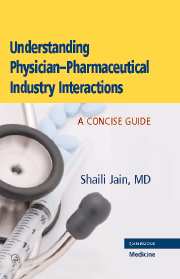Book contents
- Frontmatter
- Contents
- Acknowledgments
- Foreword
- Introduction
- 1 Gifts from the Pharmaceutical Industry to Physicians: Do They Influence your Prescribing?
- 2 Ethical Considerations of Receiving Gifts from the Pharmaceutical Industry
- 3 One on One: An Analysis of the Physician–Pharmaceutical Company Representative (PCR) Detailing Interaction
- 4 Medical Academia and the Pharmaceutical Industry
- 5 Teaching Physicians in Training about Pharmaceutical Industry Promotion
- 6 Continuing Medical Education: How to Separate Continuing Medical Education from Pharmaceutical Industry Promotion
- 7 Professional Policies on Physician–Pharmaceutical Industry Interaction (PPII)
- 8 Preserving Professionalism: Patients' Perceptions of Physicians' Acceptance of Gifts from the Pharmaceutical Industry
- 9 To Sample or Not to Sample? The Use of Pharmaceutical Industry–Supplied Medications in Medical Practice
- 10 Physician–Pharmaceutical Industry Interactions (PPIIs), the Law and the Media
- 11 Direct-to-Consumer Advertising (DTCA)
- 12 Pharmaceutical Industry Interactions with Health Care Professionals: A Global Perspective
- 13 Internet Resources for Teaching about PPII and Independent Sources of Information about Prescription Medicines
- Appendix I
- Appendix II
- Index
- References
3 - One on One: An Analysis of the Physician–Pharmaceutical Company Representative (PCR) Detailing Interaction
Published online by Cambridge University Press: 03 March 2010
- Frontmatter
- Contents
- Acknowledgments
- Foreword
- Introduction
- 1 Gifts from the Pharmaceutical Industry to Physicians: Do They Influence your Prescribing?
- 2 Ethical Considerations of Receiving Gifts from the Pharmaceutical Industry
- 3 One on One: An Analysis of the Physician–Pharmaceutical Company Representative (PCR) Detailing Interaction
- 4 Medical Academia and the Pharmaceutical Industry
- 5 Teaching Physicians in Training about Pharmaceutical Industry Promotion
- 6 Continuing Medical Education: How to Separate Continuing Medical Education from Pharmaceutical Industry Promotion
- 7 Professional Policies on Physician–Pharmaceutical Industry Interaction (PPII)
- 8 Preserving Professionalism: Patients' Perceptions of Physicians' Acceptance of Gifts from the Pharmaceutical Industry
- 9 To Sample or Not to Sample? The Use of Pharmaceutical Industry–Supplied Medications in Medical Practice
- 10 Physician–Pharmaceutical Industry Interactions (PPIIs), the Law and the Media
- 11 Direct-to-Consumer Advertising (DTCA)
- 12 Pharmaceutical Industry Interactions with Health Care Professionals: A Global Perspective
- 13 Internet Resources for Teaching about PPII and Independent Sources of Information about Prescription Medicines
- Appendix I
- Appendix II
- Index
- References
Summary
The Nature of Detailing
Historically, the method of promotion that has proven most effective for the pharmaceutical industry is the process of detailing, in which PCRs visit physician offices to discuss the availability and suitability of products. PCRs are the link between the company and the physician. They contact an average of 8–10 medical offices in a day with the goal of influencing physicians to prescribe their company's brands. In recent years, sales representative presence has apparently increased significantly, with 83% of physicians in one study acknowledging visits from PCRs regardless of physician age, gender and specialty.
In 1998 the pharmaceutical industry (PI) spent $12.724 billion on promotion in the United States, with $3.537 billion on office promotion. Constant interactions build a stock of goodwill between a PCR and the physician, and this changes physician prescription behavior in a “positive” way (i.e., favorable to the company).
The importance of an actual relationship between PCR and physician has been highlighted in marketing journals. “Loyalty to a PCR who has become a friend to the physician may prove stronger than loyalty to the brand”. This philosophy may help to explain why, historically, there has been much emphasis placed on the choice of proper personnel to act as emissaries for the company: for example, “have a good appearance, pleasing personality, moderate habits, good health and physical fitness”.
- Type
- Chapter
- Information
- Understanding Physician-Pharmaceutical Industry InteractionsA Concise Guide, pp. 12 - 15Publisher: Cambridge University PressPrint publication year: 2007



